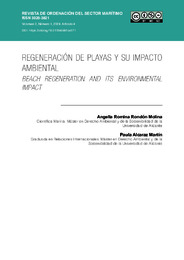Please use this identifier to cite or link to this item:
https://hdl.handle.net/11000/32457Full metadata record
| DC Field | Value | Language |
|---|---|---|
| dc.contributor.author | Rondón Molina, Angella Romina | - |
| dc.contributor.author | Alcaraz Martín, Paula | - |
| dc.contributor.other | Departamentos de la UMH::Ciencia Jurídica | es_ES |
| dc.date.accessioned | 2024-07-15T08:57:33Z | - |
| dc.date.available | 2024-07-15T08:57:33Z | - |
| dc.date.created | 2024 | - |
| dc.identifier.citation | Revista de ordenación del sector marítimo, Volumen 2, Número 1, 2024. Artículo 4 | es_ES |
| dc.identifier.issn | 3020-3821 | - |
| dc.identifier.uri | https://hdl.handle.net/11000/32457 | - |
| dc.description.abstract | El litoral marino es un ambiente dinámico, con una compleja variación natural dependiente de sus interacciones biológicas, físicas y geológicas. En los últimos años las gestiones ambientales locales y regionales han modificado nuestras costas por intereses socioeconómicas, eliminando el abasteci-miento natural de sedimentos a nuestro litoral. Como consecuencia de ello, las autoridades se vieron obligadas a realizar técnicas de regeneración de playas para proteger y conservar este espacio natu-ral, y también, impulsar la actividad económica en el sector, como el turismo. El presente trabajo tiene como finalidad estudiar el impacto ambiental que conlleva la regeneración de playas. Para cumplir estos objetivos se define la morfología natural de la costa y sus depósitos naturales de sedimentos, el impacto hacia las praderas de Posidonia oceánica y el marco jurídico que abarca la gestión en el litoral. | es_ES |
| dc.description.abstract | The marine coastline is a dynamic environment, with a complex natural variation dependent on its biological, physical and geological interactions. In the last years, local and regional environmental managers have modified our coasts for socioeconomic interests, eliminating the natural supply of sediments to our coastline. As a consequence, the authorities were forced to carry out beach regen-eration techniques to protect and conserve this natural space, and also, to promote economic activity in the sector, such as tourism. The purpose of this work is to study the environmental impact of beach regeneration. To meet these objectives, the natural morphology of the coast and its natural sediment deposits, the impact on the Posidonia oceánica meadows and the legal framework covering coastal management are defined | es_ES |
| dc.format | application/pdf | es_ES |
| dc.format.extent | 16 | es_ES |
| dc.language.iso | spa | es_ES |
| dc.publisher | Universidad Miguel Hernández | es_ES |
| dc.rights | info:eu-repo/semantics/openAccess | es_ES |
| dc.rights.uri | http://creativecommons.org/licenses/by-nc-nd/4.0/ | * |
| dc.subject | Gestión | es_ES |
| dc.subject | regeneración | es_ES |
| dc.subject | litoral | es_ES |
| dc.subject | Posidonia oceánica | es_ES |
| dc.subject | regulación | es_ES |
| dc.subject | Management | es_ES |
| dc.subject | regeneration | es_ES |
| dc.subject | coastal | es_ES |
| dc.subject | Posidonia oceanica | es_ES |
| dc.subject | sediments | es_ES |
| dc.subject | regulation | es_ES |
| dc.subject.other | CDU::3 - Ciencias sociales | es_ES |
| dc.title | Regeneración de playas y su impacto ambiental | es_ES |
| dc.title.alternative | Beach regeneration and its environmental impact | es_ES |
| dc.type | info:eu-repo/semantics/article | es_ES |
| dc.relation.publisherversion | https://doi.org/10.21134/d81bv271 | es_ES |

View/Open:
4+ROSM+Junio+REGENERACION+DE+PLAYAS+Y+SU+IMPACTO+AMBIENTAL+(1).pdf
1,05 MB
Adobe PDF
Share:
.png)
